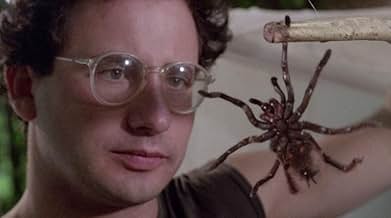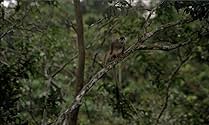VALUTAZIONE IMDb
4,0/10
1063
LA TUA VALUTAZIONE
Quattro amici si dirigono nella giungla per trovare un professore scomparso, ma affrontano invece cacciatori di tesori che torturano e uccidono i nativi.Quattro amici si dirigono nella giungla per trovare un professore scomparso, ma affrontano invece cacciatori di tesori che torturano e uccidono i nativi.Quattro amici si dirigono nella giungla per trovare un professore scomparso, ma affrontano invece cacciatori di tesori che torturano e uccidono i nativi.
- Regia
- Sceneggiatura
- Star
Recensioni in evidenza
Paradiso infernale got one great weakness - it lacks almost on all fields: there is not enough gore, not enough sleaze, not enough action, not enough cheese. What we mostly get are some cliched and watered down copy scenes of "serious" cannibal movies like Cannibal Ferox and Cannibal Holocaust, one could dare to say this one is made for a mainstream audience and taken away is most of the "spice" of such kind of trashy movies. To make things worse many of the scenes feel very disjointed, somewhat it looks that every idea that crossed the minds of the writers was somewhat squeezed in. Anyway, the flick got some funny scenes and there is some cheesy feel of a cheap Indiana Jones movie, so if you are on the trip to watch everything "cannibalistic" you can put this one on your to watch list, it won't kill you - neither by total joy nor by total boredom.
Oh dear.
Firstly the dubbing is horrific! You can't take it seriously from the start. The characters are cheesy and typical 80's b-movie over the top.
The story and how it pans out is loose, random and boring. It's a bit like a kids treasure hunt. It flits from one thing to another with no depth or development.
It is completely unrealistic, silly, painful and pointless.
Firstly the dubbing is horrific! You can't take it seriously from the start. The characters are cheesy and typical 80's b-movie over the top.
The story and how it pans out is loose, random and boring. It's a bit like a kids treasure hunt. It flits from one thing to another with no depth or development.
It is completely unrealistic, silly, painful and pointless.
Antonio Climati's "The Green Inferno" is obviously inspired by Ruggero Deodato's unforgettable masterpiece "Cannibal Holocaust"(1979).Professor Koranz is missing so 4 individuals(one woman reporter and three guys)head off to the Amazon to search for him.They encounter fish that feed on the intestines of live humans,bat attacks,unfriendly headhunters,anacondas and more jungle horrors."The Green Inferno" is nothing special.It has some rather unpleasant scenes involving animals,but the amount of violence is extremely low.Still if you like Italian exploitation cinema give this obscure little flick a look.However fans of Antonio Climati's downright unpleasant mondo movies will be sorely disappointed.6 out of 10.
Antonio Climati is a man who will be remembered for one thing and one thing only: spectacularly contentious mondo films. During the 70s and early 80s, Climati produced a handful of some of the most unpleasant movies ever committed to celluloid, all in the name of "documentary". It was his 1976 film THIS VIOLENT WORLD that directly inspired some of the scenes in Deodato's exploitation classic CANNIBAL HOLOCAUST, a film which dealt a critical blow to the mondo genre. With the similarities between mondo and the violent jungle travelogue approach of the classic cannibal movie, it seems only fitting that Climati would finally try his hand at it too. Ironically, his film has clearly been strongly influenced by CANNIBAL HOLOCAUST, right down to the title...
Cannibal movie fans will immediately recognise the plot devices used in THE GREEN INFERNO from Deodato and Lenzi's past frolics in the jungle. However, it had one main difference- it was made ten years after the "golden era" of the genre. This is greatly reflected in the violence of the movie, which is enormously toned down. Whilst the "westerners captured by natives" plot remains perfectly in line with the most generic cannibal movie, there is no actual cannibalism in the picture and gore is kept to an absolute minimum. Similar to Deodato's CUT AND RUN, THE GREEN INFERNO treads the boards of a cannibal pictures whilst carefully avoiding cannibalism.
This isn't the only cannibal convention that has been sacrificed here. One of the most controversial aspects of the genre is the depiction of cruelty against and the killing of animals. Amazingly in THE GREEN INFERNO, these are replaced with scenes of COMPASSION towards animals! In one scene, a monkey is revived by the exploring party... and in total shades of CANNIBAL HOLOCAUST, at another point, a turtle is pulled out of a water tank, only to be replaced unharmed.
One has to wonder what Climati's intentions were. The awkward "anti-animal cruelty" stance that the movie seems to adopt would be easier to appreciate if one hadn't seen Climati's previous work. Movies such as SAVAGE MAN... SAVAGE BEAST positively reveled in horrifically drawn-out scenes of animal killing, so what could have changed in the meantime? In honesty, many of the animal scenes are still clearly cruel and putting the subjects under distress. This makes Climati's stance quite transparent. I honestly believe he was attempting to criticise the cannibal genre just as Deodato had damningly and directly criticised him in the past. This was also coupled with the chronological fact that audiences were simply less willing to watch animals being butchered with machetes by the time this flick was made.
As a movie, THE GREEN INFERNO is competently made yet somewhat forgettable. It has the same atmosphere as the earlier genre entries, but comes across as being rather watered down. The sound-track, photography and dialogue are all utterly perfunctory, and besides the animal issues mentioned already, a genre veteran can quite easily predict the entire plot after a few short minutes. However, in a way it is a fittingly odd end to an extremely strange genre of exploitation cinema- anaemic, bitter, and self-referentially critical.
Cannibal movie fans will immediately recognise the plot devices used in THE GREEN INFERNO from Deodato and Lenzi's past frolics in the jungle. However, it had one main difference- it was made ten years after the "golden era" of the genre. This is greatly reflected in the violence of the movie, which is enormously toned down. Whilst the "westerners captured by natives" plot remains perfectly in line with the most generic cannibal movie, there is no actual cannibalism in the picture and gore is kept to an absolute minimum. Similar to Deodato's CUT AND RUN, THE GREEN INFERNO treads the boards of a cannibal pictures whilst carefully avoiding cannibalism.
This isn't the only cannibal convention that has been sacrificed here. One of the most controversial aspects of the genre is the depiction of cruelty against and the killing of animals. Amazingly in THE GREEN INFERNO, these are replaced with scenes of COMPASSION towards animals! In one scene, a monkey is revived by the exploring party... and in total shades of CANNIBAL HOLOCAUST, at another point, a turtle is pulled out of a water tank, only to be replaced unharmed.
One has to wonder what Climati's intentions were. The awkward "anti-animal cruelty" stance that the movie seems to adopt would be easier to appreciate if one hadn't seen Climati's previous work. Movies such as SAVAGE MAN... SAVAGE BEAST positively reveled in horrifically drawn-out scenes of animal killing, so what could have changed in the meantime? In honesty, many of the animal scenes are still clearly cruel and putting the subjects under distress. This makes Climati's stance quite transparent. I honestly believe he was attempting to criticise the cannibal genre just as Deodato had damningly and directly criticised him in the past. This was also coupled with the chronological fact that audiences were simply less willing to watch animals being butchered with machetes by the time this flick was made.
As a movie, THE GREEN INFERNO is competently made yet somewhat forgettable. It has the same atmosphere as the earlier genre entries, but comes across as being rather watered down. The sound-track, photography and dialogue are all utterly perfunctory, and besides the animal issues mentioned already, a genre veteran can quite easily predict the entire plot after a few short minutes. However, in a way it is a fittingly odd end to an extremely strange genre of exploitation cinema- anaemic, bitter, and self-referentially critical.
Green Inferno (AKA Cannibal Holocaust II) is what you get if you suck all of the visceral power (and the cannibalism) out of Cannibal Holocaust. Like Deodato's infamous shocker, the film sees an intrepid female reporter and her team venture into the jungles of the Amazon to try and find a missing professor of anthropology. Unlike Deodato's film, it features no gruelling horror (unless you count the sight of a small carnivorous fish being extracted from a man's ass!), instead coming across like a National Geographic documentary crossed with a lame jungle adventure (with elements of humour). It certainly doesn't deserve to be associated with the king of all Italian cannibal movies.
Much of the film revolves around the protagonists stealing a plane and then trapping monkeys which they exchange for gas; this allows director Antonio Climati to include that genre staple -animal cruelty - but even these scenes lack the ability to shock or disgust (it's a wonder why he held back given his involvement with notorious mondo movies Africa Addio and Savage Man Savage Beast, both of which feature loads of animal violence). After successfully fuelling their stolen plane, the characters have a run in with angry natives that amounts to nothing, are attacked by bats, meet a topless jungle beauty, are captured by river pirates who are harvesting the organs of indigenous children, and eventually locate the missing professor, who is perfectly fine. No cannibalism involved whatsoever.
Much of the film revolves around the protagonists stealing a plane and then trapping monkeys which they exchange for gas; this allows director Antonio Climati to include that genre staple -animal cruelty - but even these scenes lack the ability to shock or disgust (it's a wonder why he held back given his involvement with notorious mondo movies Africa Addio and Savage Man Savage Beast, both of which feature loads of animal violence). After successfully fuelling their stolen plane, the characters have a run in with angry natives that amounts to nothing, are attacked by bats, meet a topless jungle beauty, are captured by river pirates who are harvesting the organs of indigenous children, and eventually locate the missing professor, who is perfectly fine. No cannibalism involved whatsoever.
Lo sapevi?
- QuizA real monkey is actually blow-darted in the film, resulting in 12 seconds being cut from the UK release. Despite this, however, there are no animal deaths, which is rare for an Italian-exploitation cannibal movie.
- Versioni alternativeThe film was originally passed in the UK by the BBFC in August 2002 with a '15' rating under the title "Cannibal Holocaust 2" (shorn of 12 seconds for alleged animal cruelty). It was passed uncut (with its previous cuts waived) in widescreen, again with a '15' rating, in September 2018.
- ConnessioniFeatured in The Cinema Snob: Cannibal Holocaust II (2017)
I più visti
Accedi per valutare e creare un elenco di titoli salvati per ottenere consigli personalizzati
Dettagli
- Tempo di esecuzione
- 1h 30min(90 min)
- Colore
- Mix di suoni
- Proporzioni
- 1.85 : 1
Contribuisci a questa pagina
Suggerisci una modifica o aggiungi i contenuti mancanti






















